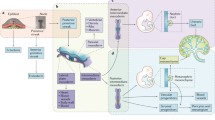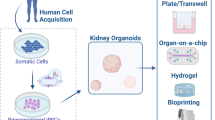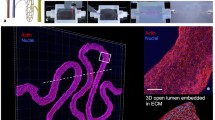Abstract
Purpose of Review
There are over 700,000 cases of end-stage renal disease in the USA, resulting in more deaths per year than prostate or breast cancer. Many researchers have proposed the generation of in vitro kidney models or implantable therapeutic replacements using biomedical engineering strategies. Because the functional unit of the kidney—the nephron—is based on tubule structures, the formation of biosynthetic tubules is at the foundation of creating models or devices to recapitulate the kidney.
Recent Findings
Recent approaches to engineering kidney tubules involve both bioengineering (perfusable microfluidic proximal tubule chips, biomaterials as scaffolds to support engineered kidney tissue units) and biological (cellular aggregates differentiated from stem cells, self-assembled kidney tubule-like structures from epithelial cells) to model kidney cells and tissues.
Summary
In this review, we detail advances in the two main approaches—bioengineering and biological—for the generation of biosynthetic kidney tubules. Although many steps have been taken towards recapitulation of kidney function, no approach has been able to recreate multiple segments of the nephron in a functional scheme.

Similar content being viewed by others
References
Papers of particular interest, published recently, have been highlighted as: • Of importance •• Of major importance
Hill NR, Fatoba ST, Oke JL, Hirst JA, O’Callaghan CA, Lasserson DS, et al. Global prevalence of chronic kidney disease - a systematic review and meta-analysis. PLoS One. 2016;11:e0158765.
United States Renal Data System. 2018 USRDS annual data report: epidemiology of kidney disease in the United States. National institutes of health, national institute of diabetes and digestive and kidney diseases, Bethesda, MD; 2018.
UNOS (2019) Transplant trends. https://unos.org/data/transplant-trends/. Accessed 3 Dec 2018.
Hart A, Smith JM, Skeans MA, et al. OPTN/SRTR 2016 annual data report: kidney. Am J Transplant. 2018;18(Suppl 1):18–113.
Catapano G, Buscaroli A. Renal function replacement by hemodialysis: forty-year anniversary and a glimpse into the future at hand. Int J Artif Organs. 2017;40:313–22.
Sladen RN. In: Miller's anesth. New York: Elsvier. Ren. Physiol; 2012. p. 441–476.
Gounden V, Jialal I. Renal function tests. StatPearls Publishing. 2019.
Weinbaum S, Duan Y, Satlin LM, Wang T, Weinstein AM. Mechanotransduction in the renal tubule. Am J Physiol Physiol. 2010;299:F1220–36.
Carrisoza-Gaytan R, Liu Y, Flores D, Else C, Lee HG, Rhodes G, et al. Effects of biomechanical forces on signaling in the cortical collecting duct (CCD). Am J Physiol Physiol. 2014;307:F195–204.
Burg MB. Introduction: background and development of microperfusion technique. Kidney Int. 1982;22:417–424. https://doi.org/10.1038/ki.1982.194.
Nagami GT. Ammonia production and secretion by isolated perfused proximal tubule segments. Miner Electrolyte Metab. 1990;16:259–63.
Schafer JA, Barfuss DW. The study of pars recta function by the perfusion of isolated tubule segments. Kidney Int. 1982;22:434–48.
Weber HM, Tsurkan MV, Magno V, Freudenberg U, Werner C. Heparin-based hydrogels induce human renal tubulogenesis in vitro. Acta Biomater. 2017;57:59–69.
Subramanian B, Kaya O, Pollak MR, Yao G, Zhou J. Guided tissue organization and disease modeling in a kidney tubule array. Biomaterials. 2018;183:295–305.
Batchelder CA, Martinez ML, Tarantal AF. Natural scaffolds for renal differentiation of human embryonic stem cells for kidney tissue engineering. PLoS One. 2015;10:e0143849.
• Yamaguchi S, Morizane R, Homma K, et al. Generation of kidney tubular organoids from human pluripotent stem cells. Sci Rep. 2016;6:38353. This study describes methods developed for the generation of kidney tubular organoids from iPS cells.
•• Takasato M, Er PX, Chiu HS, Maier B, Baillie GJ, Ferguson C, et al. Kidney organoids from human iPS cells contain multiple lineages and model human nephrogenesis. Nature. 2015;526:564–8. This study provides a thorough description of the methods developed for the generation of multilineage kidney organoids from iPS cells.
King SM, Higgins JW, Nino CR, et al. 3D proximal tubule tissues recapitulate key aspects of renal physiology to enable nephrotoxicity testing. Front Physiol. 2017;8:123.
Weber EJ, Chapron A, Chapron BD, Voellinger JL, Lidberg KA, Yeung CK, et al. Development of a microphysiological model of human kidney proximal tubule function. Kidney Int. 2016;90:627–37.
Vedula EM, Alonso JL, Arnaout MA, Charest JL. A microfluidic renal proximal tubule with active reabsorptive function. PLoS One. 2017;12:e0184330.
• Homan KA, Kolesky DB, Skylar-Scott MA, Herrmann J, Obuobi H, Moisan A, et al. Bioprinting of 3D hips. Sci Rep. 2016;6:34845. This work demonstrates the potential for 3D bioprinting to be used for the creation of tissue-on-chip models of organ function.
•• Jansen J, De Napoli IE, Fedecostante M, et al. Human proximal tubule epithelial cells cultured on hollow fibers: living membranes that actively transport organic cations. Sci Rep. 2015;5:16702. This system demonstrates a scalable approach to generation of multiplexed kidney tubule-like structures that are able to perform some of the key functions of native proximal tubule.
• Secker PF, Luks L, Schlichenmaier N, Dietrich DR. RPTEC/TERT1 cells form highly differentiated tubules when cultured in a 3D matrix. ALTEX. 2018;35:223–34. This study represents a key effort in the self-assembled approach to the production of polarized proximal tubules that demonstrate key functional markers.
Benedetti V, Brizi V, Guida P, Tomasoni S, Ciampi O, Angeli E, et al. Engineered kidney tubules for modeling patient-specific diseases and drug discovery. EBioMedicine. 2018;33:253–68.
Abolbashari M, Agcaoili SM, Lee M-K, Ko IK, Aboushwareb T, Jackson JD, et al. Repopulation of porcine kidney scaffold using porcine primary renal cells. Acta Biomater. 2016;29:52–61.
Vormann MK, Gijzen L, Hutter S, Boot L, Nicolas A, van den Heuvel A, et al. Nephrotoxicity and kidney transport assessment on 3D perfused proximal tubules. AAPS J. 2018;20:90.
Bajaj P, Rodrigues AD, Steppan CM, Engle SJ, Mathialagan S, Schroeter T. Human pluripotent stem cell-derived kidney model for nephrotoxicity studies. Drug Metab Dispos. 2018;46:1703–11.
Jansen J, Fedecostante M, Wilmer MJ, Peters JG, Kreuser UM, van den Broek PH, et al. Bioengineered kidney tubules efficiently excrete uremic toxins. Sci Rep. 2016;6:26715.
Suter-Dick L, Mauch L, Ramp D, Caj M, Vormann MK, Hutter S, et al. Combining extracellular miRNA determination with microfluidic 3D cell cultures for the assessment of nephrotoxicity: a proof of concept study. AAPS J. 2018;20:86.
Ardeshirylajimi A, Vakilian S, Salehi M, Mossahebi-Mohammadi M. Renal differentiation of mesenchymal stem cells seeded on nanofibrous scaffolds improved by human renal tubular cell lines-conditioned medium. ASAIO J. 2017;63:356–63.
• Wilmer MJ, Ng CP, Lanz HL, Vulto P, Suter-Dick L, Masereeuw R. Kidney-on-a-chip technology for drug-induced nephrotoxicity screening. Trends Biotechnol. 2016;34:156–70. This study demonstrates the use of a kidney-on-a-chip model for screening of drug-induced nephrotoxicity, which would enhance in vitro drug screenings capabilities and thus improve clinical trial outcomes.
Shanti A, Teo J, Stefanini C. In vitro immune organs-on-chip for drug development: a review. Pharmaceutics. 2018;10:278.
Nieskens TTG, Wilmer MJ. Kidney-on-a-chip technology for renal proximal tubule tissue reconstruction. Eur J Pharmacol. 2016;790:46–56.
Peattie RA, Fisher RJ. Perfusion effects and hydrodynamics. Adv Biochem Eng Biotechnol. 2007;103:75–156.
Yonemura S. Differential sensitivity of epithelial cells to extracellular matrix in polarity establishment. PLoS One. 2014;9:e112922.
Ruhfus B, Bauernschmitt HG, Kinne RK. Properties of a polarized primary culture from rat renal inner medullary collecting duct (IMCD) cells. In Vitro Cell Dev Biol Anim. 1998;34:227–31.
Minuth WW, Schumacher K, Strehl R. Renal epithelia in long term gradient culture for biomaterial testing and tissue engineering. Biomed Mater Eng. 2005;15:51–63.
Fukuda Y, Kaishima M, Ohnishi T, Tohyama K, Chisaki I, Nakayama Y, et al. Fluid shear stress stimulates MATE2-K expression via Nrf2 pathway activation. Biochem Biophys Res Commun. 2017;484:358–64.
Montesano R, Schaller G, Orci L. Induction of epithelial tubular morphogenesis in vitro by fibroblast-derived soluble factors. Cell. 1991;66:697–711.
Maeshima A, Zhang YQ, Furukawa M, Naruse T, Kojima I. Hepatocyte growth factor induces branching tubulogenesis in MDCK cells by modulating the activin-follistatin system. Kidney Int. 2000;58:1511–22.
Hirashima T, Hoshuyama M, Adachi T. In vitro tubulogenesis of Madin–Darby canine kidney (MDCK) spheroids occurs depending on constituent cell number and scaffold gel concentration. J Theor Biol. 2017;435:110–5.
Caralt M, Uzarski JS, Iacob S, Obergfell KP, Berg N, Bijonowski BM, et al. Optimization and critical evaluation of decellularization strategies to develop renal extracellular matrix scaffolds as biological templates for organ engineering and transplantation. Am J Transplant. 2015;15:64–75.
Love HD, Ao M, Jorgensen S, et al (2018) Substrate elasticity governs differentiation of renal tubule cells in prolonged culture. Tissue Eng Part A. https://doi.org/10.1089/ten.tea.2018.0182.
Takasato M, Little MH. Making a kidney organoid using the directed differentiation of human pluripotent stem cells. In: Methods Mol Biol. 2017;195–206. https://doi.org/10.1007/978-1-4939-6949-4_14.
Gozalpour E, Fenner KS. Current State of in vitro cell-based renal models. Curr Drug Metab. 2018;19:310–26.
Takasato M, Er PX, Chiu HS, et al. Generation of kidney organoids from human pluripotent stem cells. Protoc Exch. 2015;11:1681–92.
Acknowledgments
We thank the members and administrators of the (Re) Building a Kidney consortium.
Funding
We thank the NIH (R24DK106743) for financial support.
Author information
Authors and Affiliations
Ethics declarations
Conflict of Interest
The authors declare that they have no conflict of interest.
Human and Animal Rights and Informed Consent
This article does not contain any studies with human or animal subjects performed by any of the authors.
Additional information
Publisher’s Note
Springer Nature remains neutral with regard to jurisdictional claims in published maps and institutional affiliations.
This article is part of the Topical Collection on Tissue Engineering and Regeneration
Rights and permissions
About this article
Cite this article
Szymkowiak, S., Kaplan, D. Biosynthetic Tubules: Multiscale Approaches to Kidney Engineering. Curr Transpl Rep 6, 214–220 (2019). https://doi.org/10.1007/s40472-019-00248-z
Published:
Issue Date:
DOI: https://doi.org/10.1007/s40472-019-00248-z




